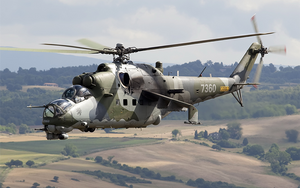HH1 Helicopter Gunship
This article is incomplete because it is pending further input from participants, or it is a work-in-progress by one author. Please comment on this article's talk page to share your input, comments and questions. Note: To contribute to this article, you may need to seek help from the author(s) of this page. |
| HH1 Halászsas | |
|---|---|

| |
| Role | Attack helicopter, military transport |
| National origin | |
| Manufacturer | Vanagan-Berj |
| First flight | 11 October 1968 |
| Introduction | 22 May 1972 |
| Status | In active service |
| Primary user | |
| Produced | 1969 – Present |
| Number built | ~980 |
The Vanagan-Berj HH1 Halászsas is a double-seat Ruvelkan helicopter gunship and low-capacity troop transport for eight passengers. Development of the Halászsas began in the mid-1960s and was intended to serve as a special operations armed transport enabling Ruvelka’s mobile infantry to deploy rapidly to anywhere within the country. After extensive testing, it achieved operational readiness and was introduced into the Ruvelkan Military in 1972. It has since become a staple of Ruvelka’s military doctrine having been adopted in some form by all branches.
Development
The advent of helicopter transports promoted high-ranking members of the Ruvelkan military to promote research in the development of alternative forms of transport for all branches of the nation’s armed forces. The geography of Ruvelka was infamously well-known for its ruggedness and difficulty to traverse. While this was a key component of the Ruvelkan military’s strategy of defense-in-depth post-Siduri War, it was also a major obstacle in the rapid deployment of Ruvelkan troops.
In the very early 1960s, a hypothetical proposal for an air-mobile infantry fighting vehicle was initially proposed and a handful of design bureaus began setting out to develop armored vehicles to fulfill this role. Initially, helicopter transports were to be developed to carry these vehicles to their theater of operation, however this proved difficult as any armored vehicle light enough be carried by helicopters at the time would be too lightly armored. While Valentin Berj had set out to design the transport helicopter that would eventual result in the ARH family, Arkina Vanagan instead proposed the idea of the helicopter itself doubling as both transport and fighting vehicle.
Arkina approached the leaders of the Ruvelkan military in 1967 with the first draft of what she had dubbed as a “helicopter gunship”. Given the designation “Projekt 967”, the helicopter had a central infantry compartment that could transport up to eight infantry and a pair of wings for any number of supplemental weapons for additional firepower. The hypothesis for the helicopter gunship garnered immediate traction and support for its development came from nearly all branches of armed forces. Engineers and Vanagan-Berj prepared two basic designs, a single-engine hull and double-engine hull, from which a various number of mock-ups with varying cockpits were designed.
On 11 December 1967, orders to proceed with the twin-engine design were issued and work on a final prototype began throughout 1968. The prototype made its first tethered test-flight on 15 September 1968 and the first free-flight on 11 October 1968. Afterward, a second prototype was constructed and tested and was later followed by a test batch of ten. Over the course of the next two years, extensive testing was conducted which improved on the aircraft’s structural strength as well as problems with fatigue and vibration. Initial production of the HH1 began in 1971 and entered into active service in May the following year.
Design
Overview
The main hull of the HH1 was heavily based on the Vanagan-Berj ARH6 which was previously designed with two top-mounted turboshaft engines which drove a mid-mounted five-bladed rotor and three-bladed tail rotor. For the HH1, the tail boom was modified and the rear access point removed. The first iterations of the HH1 possessed an angular glass cockpit, but this was quickly abandoned in favor of a tandem cockpit with the now-characteristic double-bubble canopy.
Unlike previous helicopters, the HH1’s fuselage is heavily armored and capable of withstanding direct impacts from 12.7mm rounds from any angle; the titanium rotor blades are also rated to resist similar ammo types. The glass of the canopy is ballistic resistance and both seats for the pilot and weapons system officer are encased in a titanium-armored tub.
The primary configuration of the HH1 includes a 12.7 mm gatling gun housed in its gyrostabilized nose-turret, but other configurations would later include a 30 mm autocannon. A pair of mid-mounted stub wings are equipped with weapon hardpoints that allow for a variety of weapons loadouts which are most often configured for mission parameters. As a result, the HH1 is capable of fulfilling a number of roles that include close air support, anti-tank operations, and low-altitude aerial combat.
Operational History
Imerti Conflict
Zemplen War
Specifications
General Characteristics
- Crew: 2
- Capacity: 8 troops / 4 stretchers / 2,400 kg (5,291 lbs) on an external sling
- Length: 17.5 m (57 ft 5 in)
- Height: 6.5 m (21 ft 4 in)
- Empty Weight: 8,500 kg (18,739 lbs)
- Max Takeoff Weight: 12,000 kg (26,455 lbs)
- Powerplant: 2 × Vazken VB-112 turboshaft engines, 1,600 kW (2,200 shp) each
- Main Rotor Diameter: 17.3 m (56 ft 9 in)
- Main Rotor Area: 235.1 m² (2,531 sq ft) 5-bladed main rotor
Performance
- Maximum Speed: 335 km/h (208 mph; 181 kn)
- Range: 450 km (280 mi; 240 nmi)
- Service Ceiling: 4,900 m (16,100 ft)
Armament
- Guns: 1 × 12.7 mm gatling gun with 1,470 rounds; Passenger compartment window-mounted machine guns.
- Hardpoints: 6 hardpoints (4 underwing, 2 wingtip); 2 wingtip pods armed with chaff and flare countermeasures.